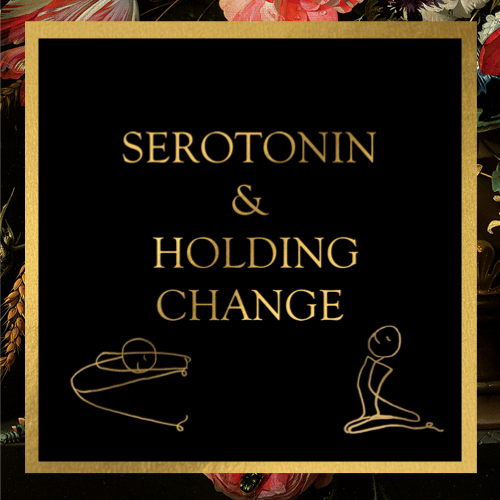Happy New Year! How is 2022 for you so far? Have you set yourself goals? Are you sticking to them?
Today we are going to dip into one concept, idea, area of study, that may be useful in considering how practises such as Kundalini Global, which work to change hormonal flow within the body, may be helpful to you in holding change.
On that topic, on Thursday this week, Carolyn Cowan is giving a talk for Alternatives in which you can learn about the thought processes, tools, and ways to reset and support new habits. Carolyn will show you how to support change and transformation in this time. It is at 7pm UK time and you can book a space here:
Alternatives: Holding Change With Carolyn Cowan. Find out more/book.

Now is the time for change…
A survey of 2,000 people, with representative quotas for gender, age and region in December 2021, suggests that, in the UK alone, 28 million people (54% of the population) will have woken up on this Monday morning to the third day of working with some form of New Year’s resolution.
It is perhaps quite unsurprising that goals around health are the most popular (a quarter of all resolutions are relative to health). And such goals can feel incredibly tricky to stick with. A big part of this comes to our ability to hold patience with goals, projects, ideas and hopes that do not offer instant reward. And a lot of that is to do with our impulse control.
What is it that makes us impulsive? A topic far too big for a short post on this page.
But do you ever stop to consider why we find it so easy to say yes, when a no would better support us in our goals?
Much scientific study has looked into the brain science, the neural mechanisms, behind impulsivity. And some of the most interesting, and more recent, research suggests that two areas of the brain work together in response to a neurotransmitter you will offer hear us talk about in Kundalini Global classes, serotonin, to promote the ability to wait patiently and practice impulse control.
What is Serotonin?
Serotonin is neurotransmitter and it is, as you may suspect, present in our brains. However, 90% of our total serotonin is actually found in the gut (specifically in enterochromaffin cells which you can also get really deep into reading about in terms of how they are studied). Its job there, in part, is relative to regulating the movement of our digestive system.
In addition to aiding digestion, serotonin is involved in regulating our sleep, mood, appetite, concentration, body temperature… and much more.
Much research exists on the relationship between serotonin and our behaviour, including behaviours related to impulsivity.
Could consciously working on the release of Serotonin help you hold your goals for this year?
We can’t make big claims on that. But the science is fascinating.
Researchers, scientists, human beings, do not fully understand the neurological processes involved in our ability to regulate patience and have impulse control.
However researchers have found ways that serotonin acts on specific regions of the brain to regulate the ability to wait for a desired reward.
In one study researchers focused on regions of the brain that research has shown, when damaged, leads to an increase in impulsive behaviours.
We won’t go into all the detail here, and if you get triggered by research on animals, you may not want to read in full, but if you would like to go deeper you will find it here: https://www.science.org/doi/10.1126/sciadv.abc7246
The study suggested that serotonin enhanced patience and improved impulse control when mice used in the study were confident that a reward would eventually appear. Even when they were not sure exactly when it would come.
How do we work on Serotonin Release in Kundalini Global?
If you read up on what is widely recommended to boost serotonin levels naturally, the science comes to several suggestions that include self massage, exercise, and natural sunlight.
Relative to what we know about where, within the body, the majority of Serotonin is found, in Kundalini Global we work with many, gentle, flexing and compressing movements, that massage the gut. Sufi Grind is the perfect example as we flex and compress continuously.
The impact of releasing large amounts of serotonin is, within the container of a class, not so much about impulse control but about creating safety. Although it is always interesting to do notice if you can control the impulse to open your eyes/check your phone etc. at the end of a posture, before you lie back.
Serotonin plays a huge part in bringing us to stillness, allowing us to bear the stillness, after posture in classes.
We are softened, we are gentle, and this can allow us the safety to be in the present moment.
In this safety, in a class, we can lie down on to the mat and allow transformation as our body scavenges all of the serotonin we have produced.
Some postures for aiding serotonin release from the gut:
Sufi Grind – massages the Internal organs, including the intestines and the stomach which produces most of the Serotonin in the body. We also ‘flex’ which is also wonderful for serotonin release.
Life Nerve Stretch/The Maha Mudra – flexes and also massages the internal organs as you fold forward.
Spinal Flex, massages the Internal organs, particularly when done slowly and consciously.
We cannot claim that we have all the answers, but we have experienced for ourselves, and see in our clients, the difference that the breaths and postures we work with make to how we experience ourselves.
Now is a great time to take on a practise, a class, a series, to hold change as you move forward in 2022. Check out our teachers listed here. And do let us know your thoughts on this post.

